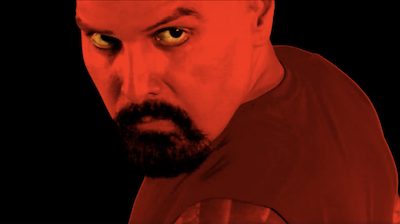by David Kulma

The concert began with another of Stravinsky’s Russian-period works: the Three Pieces for String Quartet (1914). Written a year after the premiere of his succès de scandale, The Rite of Spring, this short, acerbic set has all the ingredients of his famous ballets, including deranged folk-like melodies, abrupt textural shifts, and glassy, evanescent parallels. Violinists James Thompson and Julian Maddox, violist Gabriel Napoli, and cellist Joseph Teeter played with precise aggression mixed with the requisite unnerving coldness.
The first half concluded with Kasumi’s 2010 video work Quadroscope, fit to Esa-Pekka Salonen’s 2006 Catch and Release. A companion piece to L’Histoire, the Salonen features the same instrumentation: violin (Julian Maddox), double bass (Tristen Jarvis), clarinet (Mason Sangster), bassoon (Brendon Still), trumpet (Joseph Boughton), trombone (David Hector), and percussion (Sasha Luthy) — all under the confident hands of conductor Dean Buck.
The music owes much to John Adams’s Chamber Symphony. It is constantly shifting, splendidly ludicrous, and virtuosic in the extreme. The musicians tore through it with blinding skill, especially Sangster’s thrilling, spinning solos.
Kasumi’s video was both visually sumptuous and light-hearted. She matched each movement with continuously changing details from her bag of visuals — wiggling fingers, piled-up numbers, kaleidoscopic fluorescent squiggles, and concerned faces from mid-century B-horror movies. She regularly spliced and mixed her motives, giving her work a pleasant, musicianly air.
The 35-minute Suite from L’Histoire du soldat served as the musical bedrock for the premiere of Kasumi’s intense and politically pointed video A Soldier’s Tale. Wearing headphones to sync the audio and video, Buck led Thompson, Jarvis, Sangster, Sill, Boughton, trombonist Giovanni Miceli, and percussionist Matt Moore in a searingly precise performance of Stravinsky’s classic update of the Faust legend. Playing his violin rigorously, Thompson perfectly evoked the forceful soldier.
Kasumi successfully captures much of the character of Stravinsky’s take on a soldier selling his soul to the devil. Clearly her best decisions were the beautifully shot scenes featuring the visually electric dancer Martin Céspedes. Without saying a word, he fulfilled every needed emotion from pensive sadness to laugh-out-loud evilness.
All of Kasumi’s earlier techniques were at play, especially the quicksilver juxtapositions featuring old stock footage. But the joy of Quadroscope became in A Soldier’s Tale a haunted and didactic critique of 21st-century America. She aligns the opening rhythmic gesture with a gigantic nuclear explosion. And the postmodern-art equivalent of Godwin’s Law was in full effect: Nazi salutes appeared by the fourth movement. Even with Kasumi’s astounding visual skills, her political directness blunted Stravinsky’s musical irony.
Published on ClevelandClassical.com October 30, 2018.
Click here for a printable copy of this article



